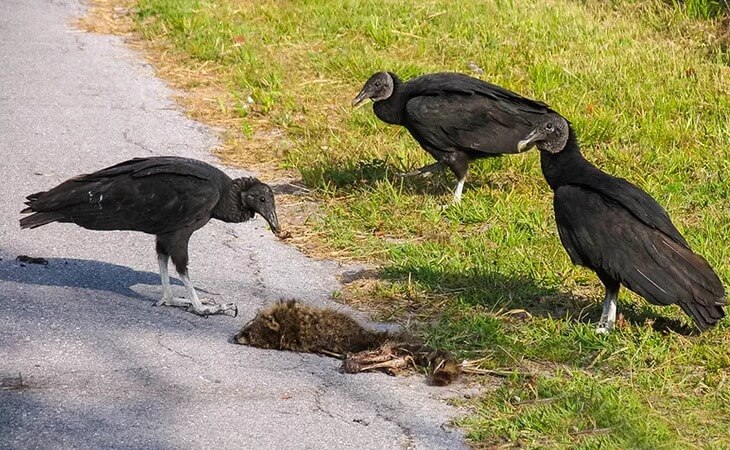Interesting Facts About Vultures Of Michigan (2 Species)
In the vast expanse of Michigan’s diverse landscapes, a remarkable avian presence often goes unnoticed—the vultures. These misunderstood scavengers, with their majestic wingspans and keen sense of smell, play an essential role in maintaining the delicate balance of our ecosystem. While many may shudder at the thought of these creatures circling overhead, they are more than mere harbingers of death; they are nature’s cleanup crew, tirelessly working to recycle nutrients and prevent the spread of disease.
The vultures of Michigan—primarily composed of turkey vultures and black vultures—embody resilience and adaptability in a rapidly changing environment. As their populations fluctuate and expand across the Great Lakes region, they offer us a unique glimpse into the health of our ecosystems. In this article, we will delve into the fascinating lives of these birds: their behaviors, habitats, and interactions with both wildlife and humans. Join us as we uncover why these enigmatic creatures deserve not only our respect but also our admiration as vital players in nature’s intricate web.
Vultures of Michigan
There are two species of vultures that exist in michigan:

- Turkey Vulture
- Black Vulture (Rare)
Turkey Vulture
Scientific Name: Cathartes aura
Turkey vultures, with their striking black feathers and characteristic bald heads, offer a fascinating glimpse into the ecosystem of Michigan. These birds play a critical role as nature’s cleanup crew, swooping in to feast on carrion that might otherwise spread disease. Despite their grim diet, turkey vultures exhibit an elegant grace in flight; they are skilled gliders, soaring on thermals for hours without flapping their wings. This energy-efficient behavior not only highlights their adaptability but also reminds us of the intricate balance within our environment.

One particularly interesting aspect of turkey vultures is their keen sense of smell—an ability rare among birds. While many scavengers rely heavily on sight, these creatures can detect ethyl mercaptan, a gas released during decomposition, from miles away. This adaptation showcases how evolution tailors species to thrive in specific niches and underscores their importance in maintaining ecological health. In Michigan’s diverse habitats—from wooded areas to open fields—turkey vultures exemplify the often-overlooked beauty and utility of scavengers in sustaining life cycles and supporting biodiversity. Observing these remarkable birds offers not only an appreciation for the role they play but also a deeper understanding of nature’s interconnectedness.
Black Vulture (Rare)
Scientific Name: Coragyps atratus
The black vulture, a rare sight in Michigan, adds an intriguing dimension to the state’s avian ecosystem. With a wingspan reaching up to 5.5 feet and a weight of around 4 to 6.6 pounds, these birds possess a uniquely robust build that sets them apart from their more commonly seen relatives, such as the turkey vulture. One key feature is their distinctive black plumage contrasted with an unusual gray head that gives them a somewhat regal appearance. While predominantly found in warmer regions of the southeastern United States, instances of black vultures migrating northward into Michigan have sparked interest among bird watchers and conservationists alike.

Their rarity in this region invites curiosity about their adaptive behaviors and environmental resilience. Black vultures prefer wooded areas near open fields or water sources where they can readily locate carrion—a primary component of their diet—while also requiring safe perches for resting and nesting. Notably, unlike many scavengers that rely solely on keen eyesight to find food, black vultures possess exceptional olfactory senses which enable them to detect decaying matter from significant distances. This characteristic could signal changing ecological dynamics as warmer climate patterns influence migration habits; observing how these magnificent birds adapt may provide valuable insights into broader environmental shifts affecting Michigan’s wildlife landscape.
Readmore: Explore Are There Badgers In Michigan?
Final Words
The Michigan vultures play a crucial role in maintaining the ecological balance by efficiently cleaning up carrion and reducing the spread of disease. Their presence is often underappreciated, yet these remarkable birds embody nature’s recycling system. As we continue to build and expand our communities, it is essential to recognize the importance of preserving their habitats and ensuring their survival.
By educating ourselves and others about their ecological contributions, we can foster a greater appreciation for these often-misunderstood creatures. Let us commit to protecting Michigan’s vultures and supporting conservation efforts that safeguard our unique wildlife for generations to come.
FAQs
What Kind Of Vultures Are In Michigan?
In Michigan, you can find two primary species of vultures: the Turkey Vulture and the Black Vulture. The Turkey Vulture is more common and recognizable by its distinctive red head and large wingspan. Black Vultures are less frequently seen in the state but can occasionally be spotted, especially in the southern regions.
Which Vulture Is Aggressive?
In Michigan, the Black Vulture is known for its aggressive behavior, especially when it comes to defending its territory and nesting sites.
- Explore Top 16 Interesting Animals That Walk On Two Legs (With Pictures) - September 19, 2024
- Explore 16 Interesting Animals That Are Independent (Images Included) - September 15, 2024
- Explore Interesting Top 10 Animals That Waddle (With Pictures) - September 15, 2024







